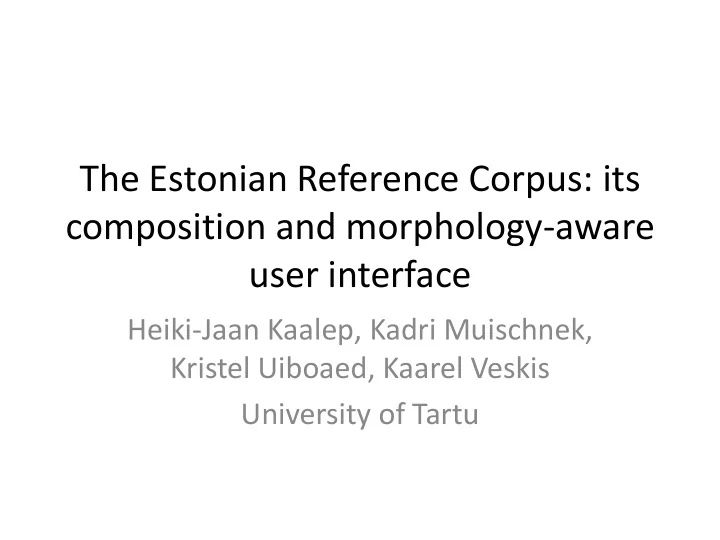

The Estonian Reference Corpus: its composition and morphology-aware user interface Heiki-Jaan Kaalep, Kadri Muischnek, Kristel Uiboaed, Kaarel Veskis University of Tartu
Composition of the Corpus Overall size: ca 245 million words non-balanced corpus; mostly standard written language 75% newspaper texts 2% fiction texts 2% science texts 5% legalese 5% parliament transcripts 9% texts of the “ new media ” The Balanced Corpus 15 million words (newspapers, fiction, science)
Availability Free for use for non-commercial purposes www.cl.ut.ee/korpused http://www.cl.ut.ee/korpused/kasutajaliides/ New, morphology-aware interface: www.keeleveeb.ee
Technical Annotation of the Corpus Technical coding and annotation: has been: TEI (Text Encoding Initiative) P3, SGML, ASCII + SGML enities will be: TEI P5, XML, utf8 Migration from TEI P3 to TEI P5 currently under way Annotated for text structure: paragraphs <p>, sentences <s>, headings <head>, authors <author> etc etc
Why does a corpus query interface need the knowledge about morphology? Estonian morphological system : agglutinating, with fusional traits, e.g. tegema ‘to do, make’ : 1.sg.prs teen ‘I do’, 1.sg.pst tegin ‘I did’, inf1 (tahan) teha ‘I ( want) to do’, inf2 (hakkan) tegema I ( start ) doing’ Morphological annotation of the Corpus enables: searching by lemmas searching by grammatical categories searching by their combinations
Morphological annotation of the Corpus Filosoft Ltd: Morphological analyzer + guesser of out-of-dictionary words HMM trigram disambigutor Quality of the analysis + disambiguation: 10% tokens still ambiguous mostly: participles; frequent verb form on ‘is, are ’ 3-6% tokens (depending on text class) have got more or less incorrect analysis
Morphology-aware user interface 1) text fields + clickable boxes, or 2) query string Features: - the number of searched items is not limited - by default, the order of searchable items in a sentence is not specified - only well-formed grammatical tags (e.g. word class, case name) are allowed - word forms, lemmas, 4-letter (and longer) substrings are allowed - exclusion, i.e. „without“ is allowed - option „immediately following“ is allowed
Näited võta ainult Tasakaalus korpus, pane enne valmis kuni täpsema otsinguni 1: tegema lemma Näita: klõpsatav allikaviide, klõpsatav sõnavorm 2. Otsimine gram kategooria järgi: Adjektiivi superlatiiv (U) sg translatiivis Otsimine gram kategooriate kombinatisooni järgi: Adjektiiv superlative in the translative case that is not used as an ??täiend. It means we should look for an adjective in superlative case in a sentence where there is no noun in a translative case 3. üks hea püsiühend: auku/augu/auk pähe rääkima The idiomatic expression ‘auku pähe rääkima’ literally means ‘to speak a hole in smb’s head’, and the metaphoric meaning of the expression is ‘to convince somebody’??või parem tõlge. While searching this expression from the corpus, one should take into account that the verb ‘to talk’, rääkima, inflects and should be retrieved using its lemma, the word- form ‘pähe’, meaning ‘into the head’ Kas see või järgmine, mõlemat ilmselt ei jõua
Näited 2 4. impersonaal + N gen + poolt Mati: Estonian has no indo-european-like proper passive, id est subjective action passive. The voice marked by special morphological form of a verb is called impersonal in Estonian grammar. The impersonal clause describes an action performed by an indefinite human agent. The main function of the impersonal voice in Estonian seems to be the ??varjamine of an agent, however, there is a limited possibility to add an agent phrase, like an english by- phrase to the clause. There has been discussion in estonian linguistics, whether it is a influence or even a borrowing from english and in what contexts the by-phrase can actually be used
Recommend
More recommend